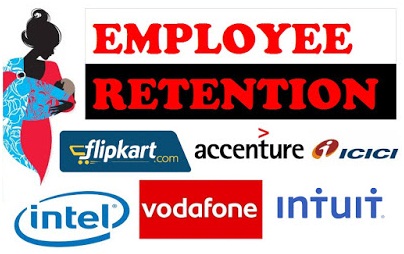
According to the Maternity Benefit Act, 1961, a women employee is entitled to get a paid maternity leave for 3 months. It has been noticed that majority of the employees do not return back to the employment post maternity period due to related reasons due to which the number of the women employees in the leadership roles have become severely low.
Looking at this critical situation where high potential talents are leaving the organisation due to the less number of leaves been availed to the women employees during the maternity period, many Indian organizations are extending the maternity leave period with additional benefits too. Some of the eminent players supporting the extended maternity leave are Flipkart, Godrej, Vodafone, Intel, Intuit, Accenture, ICICI, Adobe.
Flipkart –
- 6 months of Paid Leave
- 4 months of optional flexible working with pay.
- 1 year of career break without pay, after which they return to available jobs
- Transport Reimbursement of Rs.600 per day during the last 2 months of pregnancy.
- Stock Parking Facility i.e Reserve Parking slot for 2 months before and after the delivery
- 50% of off in day care charges for children up to 4 years of age
Vodafone India
- 4 months of paid maternity leave
- Working hours of 6 hours per day for 6 months post return of maternity
- 1 working week of paternity leave
Intuit India
- Extended paid maternity leaves
- Financial coverage of Rs.60000 for normal deliveries and up to Rs.75000 for cesarean deliveries
- Financial coverage of surrogacy and infertility treatments
Intel India
- Extended paid maternity leave of 5 months
- 1 month of flexible working option for new mothers
- 150 days of paid adoption leave for women employees
- Discounts for day care charges (Best day cares have been tied up within city)
- Financial coverage of Rs.100000 for maternity
- Continuous touch with the women employees during the maternity period to reduce the anxiety level which could arise among the employees being away from work for a long period
- Sensitivity training for all senior managers for a smooth transition to work post maternity
Godrej – 6 months paid leave
ICICI Bank – 6 Months paid leave
Adobe India – Extended paid maternity leave or adoption leave of 6.5 months
Accenture
- Extended paid maternity leave of 5 months
- Additional 1 month of paid leave
- 3 months of unpaid leave options
- Maximum maternity leave of 9 months allowed including 5 months paid
- Maternity Returners Programme – Career guidance facility for parents for re-entry into new roles post maternity period depending on the choice of the employees
- Parents at work Programme – Assistance to women employees during the maternity period to continue their job and advance in their roles and responsibilities
- Maternity Counseling Calls – Facility for the women employees during the maternity period to get counseled by a professional counselor for 6 sessions.
- Employee Assistance Programme – This helps the employees to cope up with their personal and professional hurdles which they generally face during the maternity period.
Currently only the women with government jobs in India are entitled to get a 6 months maternity leave as per the Central Civil Service (Leave) Rules, 1972. Recently Maneka Gandhi, Minister of women and child development, proposed a maternity leave 8 months. These 8 months will include 1 month of leave before the maternity and 7 months after the delivery. This decision have been kept in consideration looking into the fact of importance of breastfeeding of the new born for at least 6 months which will reduce current high rate of child malnutrition in the country. However the current status is that the labour ministry is ready to consider a 6.5 months of a maternity leave for Government and Private Sector women employees. The final decision is yet to be passed in the Parliament.
Availability of these facilities to helps to attract, motivate and retain women employees thereby reducing the attrition rate of potential talents in the organisation. Such initiatives help the women employees to return back to their workplace smoothly balancing their work as well as their personal life giving 100 percent commitment to family and the organisation.